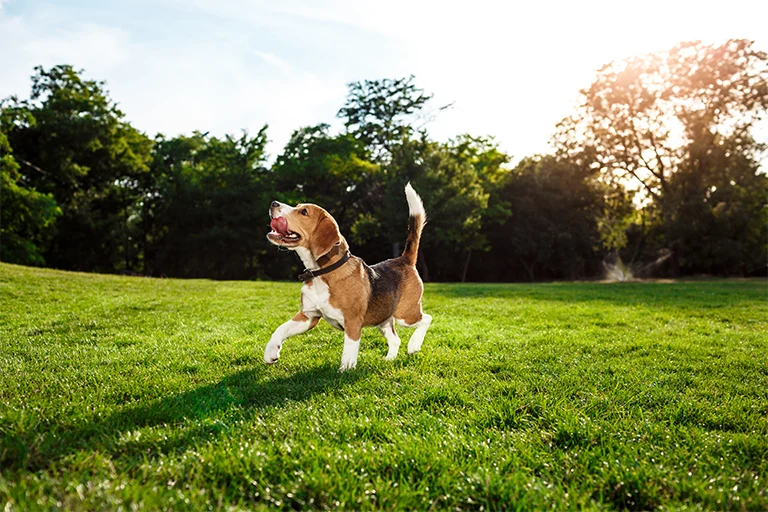Say hello to the Beagle: a small, adventurous dog with a big nose for fun. Originally from England for hunting, they’re now loved for their energy and curiosity.
Fun Facts About Beagles
- They have one of the best noses for sniffing out scents.
- They’re full of energy and love to play and explore.
- Beagles are friendly and enjoy being around people and other dogs.
Life with a Beagle
Beagles are happiest when they can follow their nose and explore. They need regular exercise and enjoy games that keep them busy. They’re great for families who love outdoor activities.
This table provides a comprehensive overview of the Beagle breed, highlighting their unique characteristics, care requirements, and other important considerations for potential owners.
| Category | Detail |
|---|---|
| Breed Name | Beagle |
| Origin | England, dating back to Roman times |
| Breed Group | Hound (AKC), Scent Hound (UKC) |
| Size Classification | Small to Medium |
| Weight Range | 20-30 lbs (9-13.5 kg) |
| Height Range | 13-15 inches (33-38 cm) at the withers |
| Life Expectancy | 10-15 years |
| Coat Type | Short, dense, and weather-proof |
| Coat Colors and Markings | Tricolor (black, brown, and white), red and white, lemon and white, and others |
| Grooming Needs | Low; regular brushing to manage shedding |
| Shedding | Moderate; sheds throughout the year |
| Temperament | Friendly, curious, merry |
| Behavioral Tendencies | Strong scenting instincts, prone to wandering if a scent is picked up |
| Social/Behavioral Traits | Great with children and other dogs, not typically aggressive |
| Activity Level | High; requires regular exercise |
| Trainability | Moderate; can be easily distracted by smells |
| Intelligence Level | Intelligent but single-minded when on a scent |
| Barking Tendency | High; known to be vocal, especially when on a scent or bored |
| Health Issues | Obesity, epilepsy, hypothyroidism, ear infections |
| Dietary Needs | Controlled diet to prevent overeating and obesity |
| Suitability for | Families, active singles, those looking for a sociable and friendly pet |
| Breed History | Originally bred for hunting small game, particularly rabbits |
| Exercise Requirements | Daily walks and playtime, secure area for off-leash exercise |
| Space Requirements | Adaptable to various living situations, but needs space for daily activity |
| Sleeping Requirements | Typically 12-14 hours a day, including naps |
| Climate Adaptability | Adaptable to most climates, but should not be left outside in extreme conditions |
| Travel and Relocation Considerations | Generally adaptable, but routine and familiarity are important |
| Compatibility Scorecard | City Living: 3/5, Families: 5/5, Novice Owners: 4/5, Exercise Enthusiasts: 4/5 |
| Ancestry and Bloodlines | Descended from hounds used for tracking in England |
| Notable Traits | Excellent sense of smell, distinctive bay, compact and sturdy build |
| Role | Companion dog, hunting dog, detection dog |
| Care Requirements | Regular exercise, mental stimulation, and consistent training |
| Cost Breakdown | Food: $20-$40/month, Grooming: Minimal, Veterinary care: $200-$500/year, Training: $50-$150/course, Insurance: $20-$40/month |
| Training and Socialization | Early socialization and obedience training are recommended |
| Time Commitment | Daily exercise and interaction are necessary |
| Enrichment Activities | Scent games, tracking exercises, interactive play |
| Common Training Mistakes | Failing to keep training sessions engaging, not managing their scenting behavior |
| Seasonal Care | Basic care; keep an eye on ear health and paw care |
| Allergy Considerations | Not hypoallergenic; sheds moderately |
| Health Screening | Hip evaluation, MLS (Musladin-Lueke Syndrome) DNA test, eye examination |
| Insurance Recommendations | Coverage for common breed-specific health issues |
| Mental Stimulation Needs | Moderate; enjoys scent work and problem-solving activities |
| Kennel Club Recognitions | AKC, UKC, FCI, and others |
| Breed Standards | Well-balanced body, strong and muscular, with a slightly domed skull |
| Litter Size | 6 puppies on average |
| Level of Protection | Low; friendly nature makes them poor guard dogs |
| Participation in Dog Sports | Excels in tracking, hunting tests, and agility |
| Noise Level | Can be noisy; known for their distinctive howl and bark |
| Odor Level | Moderate; regular grooming and ear cleaning can minimize odor |
| Watchdog/Alarm | Moderate; will alert to unfamiliar sounds and smells |
| Therapeutic Use | Often used as therapy dogs due to their gentle and friendly nature |
| Cultural Significance | Popular in literature and media, known for their hunting prowess |
| Rescue Organizations | Beagle Rescue, Education, and Welfare (BREW), Beagle Freedom Project |
| Certification and Testing | Recommended to have genetic testing for common conditions |
| FAQ Section | Q: Are Beagles good apartment dogs? A: Yes, if they receive adequate exercise. Q: Do Beagles get along with other pets? A: Generally, yes, especially if socialized early. Q: How much exercise does a Beagle need? A: At least an hour of exercise per day. |



